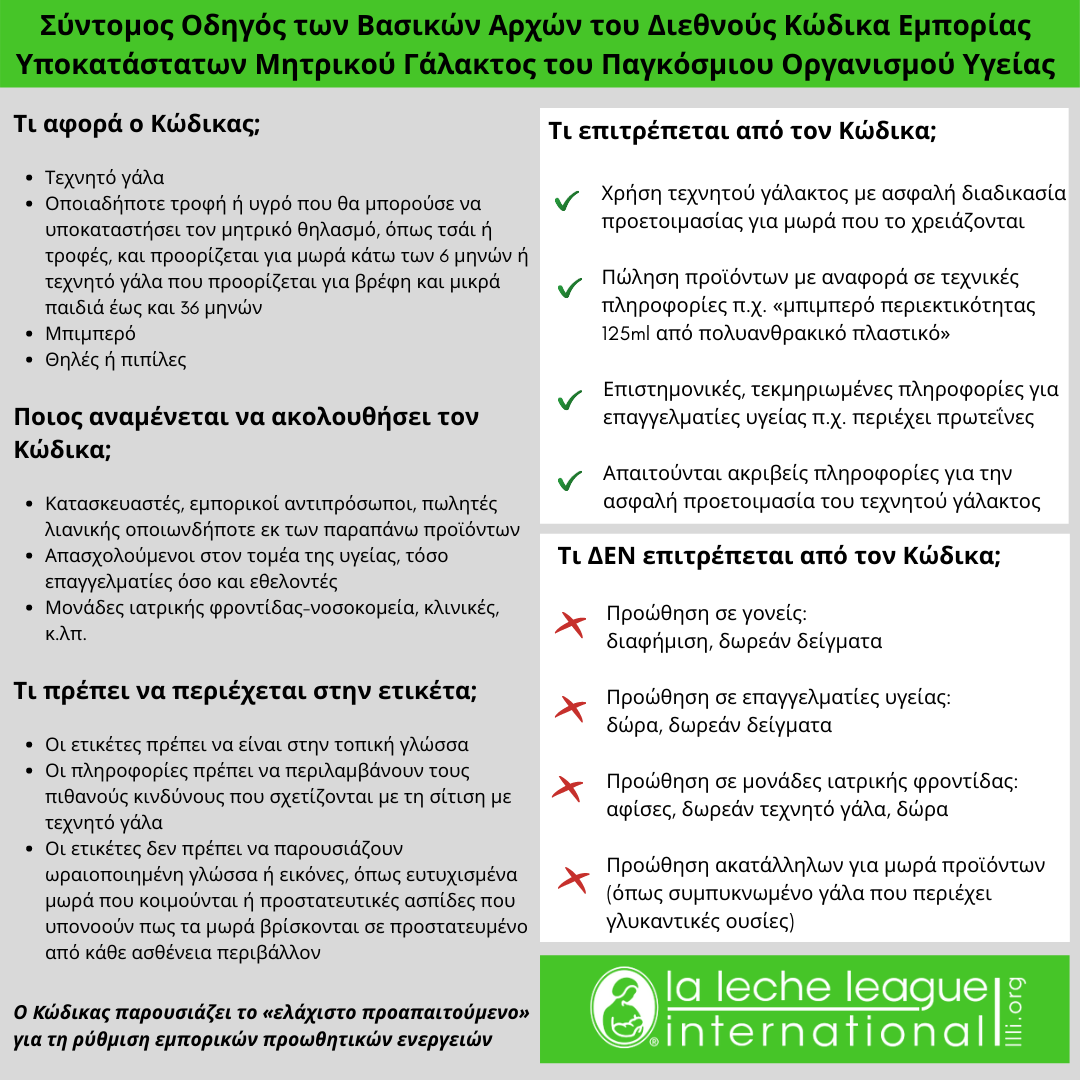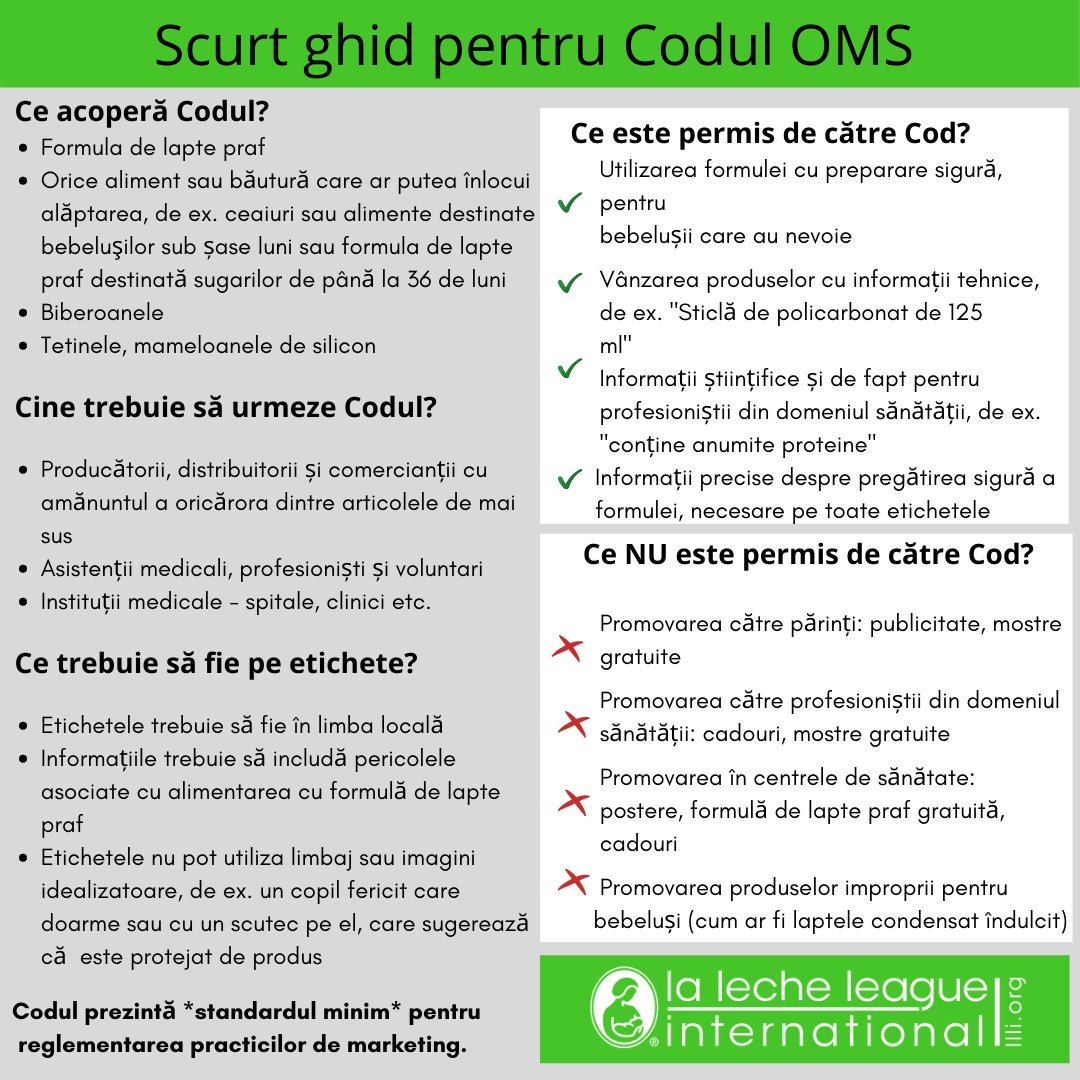International Code
Introduction
Why do we need a Code?
What is the Code in law?
What does the Code cover?
Who is expected to follow the Code?
What must be on the label?
What IS allowed under the Code?
What IS NOT allowed?
Got questions?
Further Information
Infographic: A Quick Guide to WHO Code Basics
Introduction
The International Code of Marketing of Breastmilk Substitutes from the World Health Organization (the Code) covers marketing and promotion of products meant to substitute for breastfeeding. It does not ban their sale or use; it simply restricts how they may be promoted and marketed in order to protect the health of infants and young children by supporting breastfeeding/nursing/chestfeeding.
LLLI fully supports the International Code of Marketing of Breastmilk Substitutes and subsequent World Health Assembly resolutions.
We review our partnerships and relationships regularly to ensure that we have cooperative relationships only with those who meet their obligations under the International Code.
Why do we need a Code?
The Code is needed to support infant health and prevent unscrupulous and predatory marketing practices which may undermine breastfeeding/nursing by the promotion and sale of commercial formulas.
What is the Code in law?
The Code is a World Health Assembly Resolution, a recommendation that nations pass legislation to implement the guidance in the Code so that it is enforceable. However, there is no legal penalty if a nation does not implement a resolution that they adopted. As a result, except in a very few countries that have included some parts of the Code in legislation, there is no way to penalize any manufacturer or distributor of formula or other products covered under the Code if they fail to meet their obligations under the Code.
An updated version of the Code has been issued which discusses the rules governing the marketing of breast milk substitutes.
Every other year, the World Health Assembly (WHA) reviews changes in the industry, such as communications and other technological advances allowing new means of reaching families through advertising. The WHA discusses any changes in the marketing of breastmilk substitutes that may need to be addressed for the protection of the health and development of infants and young children. Their conclusions are expressed in additional WHA resolutions that are to be read as an integral part of the Code.
What does the Code cover?
- Formula milk
- Any food or drink that would substitute for breast milk, e.g., teas or foods aimed at babies under six months, or formula aimed at any age up to 36 months
- Bottles
- Teats or nipples
Who is expected to follow the Code?
- Manufacturers and distributors of any of the above items
- Health care workers, both professionals and volunteers (including La Leche League Leaders)
- Health care systems – e.g., hospitals, clinics, and nongovernmental organizations, including La Leche League
What must be on the label?
- Labels must be in the local language and include accurate information on safe formula preparation and storage
- A warning against the health hazards of inappropriate preparation is required on all labels
- Labels must include a statement of the superiority of breastfeeding and that formula should be used only on the advice of a health worker
- Information must include the hazards and costs associated with artificial feeding
- Labels may not use idealising language or images, e.g., a happy baby sleeping, or a protective shield suggesting baby is in a protected bubble against disease
What IS allowed under the Code?
- Appropriate use of formula with safe preparation, for babies who need it, without discouraging breastfeeding/nursing
- Sale of products with technical information, e.g., “125 ml polycarbonate bottle”
- Scientific and factual information for health professionals, e.g., “contains certain proteins”, ingredients, composition, and analysis
- A warning against the health hazards of inappropriate preparation is required on all labels
What IS NOT allowed?
- Promotion to parents: advertising, free samples
- Promotion to health professionals: gifts, free samples
- Promotion in health facilities: posters, free formula, gifts
- Promotion of unsuitable products for babies (such as sweetened condensed milk)
Got questions?
Please send in all your questions on understanding the Code to info@llli.org.
This article is based on the post originally compiled by Helen Gray that was published in Leader Today, January 12, 2017. Revised and updated by Sandy Moore-Furneaux (Chair of the LLLI International Code and Conflict of Interest Committee), June 29 2020. Revised and updated by Véronique Lesoinne (co-Chair of the LLLI International Code and Conflict of Interest Committee), March 10, 2023.
Further information
Useful background on the Code can be found on the IBFAN website. For those interested in reporting violations of the International Code, here’s the link.
Baby Milk Action has a selection of publications and educational materials.
International Code of Marketing of Breast-Milk Substitutes (1981)
The 2023 Lancet Series on Breastfeeding analyzes how governments and public health ignore or fail to value breastfeeding, and exposes how the Commercial Milk Formula industry exploits women’s and parents’ insecurities about their children’s health in predatory marketing strategies.
A Quick Guide to WHO Code Basics
This infographic can be downloaded and printed for use in your communities, or shared on social media.










